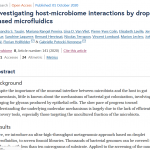MetaFluidics assembles an interdisciplinary and intersectoral consortium to develop innovative tools for functional metagenomics that will use microfluidics to enrich libraries in targeted populations, maximise functional expression and screening throughput, while reducing screening time and costs.
This general objective can be subdivided into the following tool categories:
- New molecular biotools will be developed to increase the yield of library construction and functional expression, in particular using extremophilic microorganisms to study the functional expression of genes in metagenomes from extreme environments.
- Droplet microfluidics will be implemented as a generalised technology for metagenome library enrichment, functional gene expression and screening for relevant industrial enzymes and bioactive molecules. We will use microfluidic droplets to separate library members according to the presence of particular DNA sequences prior to functional screening. Enrichment will allow access to minoritarian components of metagenomes (deep metagenomes) and maximise the success rate when screening for industrially relevant enzymes and biologically active molecules. Our objective is to provide technologies, tools and workflows that in the future can be implemented by non-specialist laboratories in industry and academia, overcoming the current inaccessibility of these technologies.
- User-friendly and resource efficient software solutions will be developed for metagenome analysis to streamline and democratise metagenomic data analysis. We will construct a software suite comprising user-friendly tools to identify single genes and/or clusters encoding multi-protein complexes in metagenomes, multiple genome alignments, annotations and pathway analysis, allowing deep insights into the genomic potential of microbial, microbial-host and microbial-viral interactions.
Finally, the new enzymes and bioactive compounds with potential industrial applications as well as the novel tools will be further developed by the industrial partners and help consolidate their competitiveness in their respective fields of industrial biotechnology, bioinformatics or microfluidics. The discovered target enzymes will first be characterised in small scale to demonstrate their activity towards specific substrates. For relevant targets, large-scale testing up to 500L will also be possible within some of the partners’ facilities.



